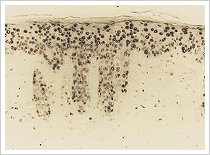

 |
|
8-hydroxy-2'-deoxyguanosine (8-OHdG) is a product of
oxidatively damaged DNA formed by hydroxy radical, singlet oxygen and direct photodynamic action.
Anti 8-OHdG monoclonal antibody (clone N45.1) is highly specific for 8-OHdG, and
is suitable for immunohistochemistry. Cross reactivity have been checked for 8-OHdG analogues (guanosine(G),7-methyl-G, 6-SH-G,
8-Bromo-G, dA, dC, dT, dI, dU, dG, O6-methyl-dG, 8-OHdA, guanine(Gua),O6-methyl-Gua,
8-OH-Gua, uric acid, urea, creatine, creatinine, 8-sulfhydryl-G, 8-OH-G).
|
|
 |
[NOTICE]: Our products are for RESEARCH USE ONLY. Not for diagnostic, medical or other use.
We are making efforts to prevent errors or mistakes on preparing web site documents, instruction manuals and products.
But even if some damage would causedby such faults, we will be exempt from responsibility.
|
Copyright ©
Genox Corporation. All rights reserved.
|






















































 )
)